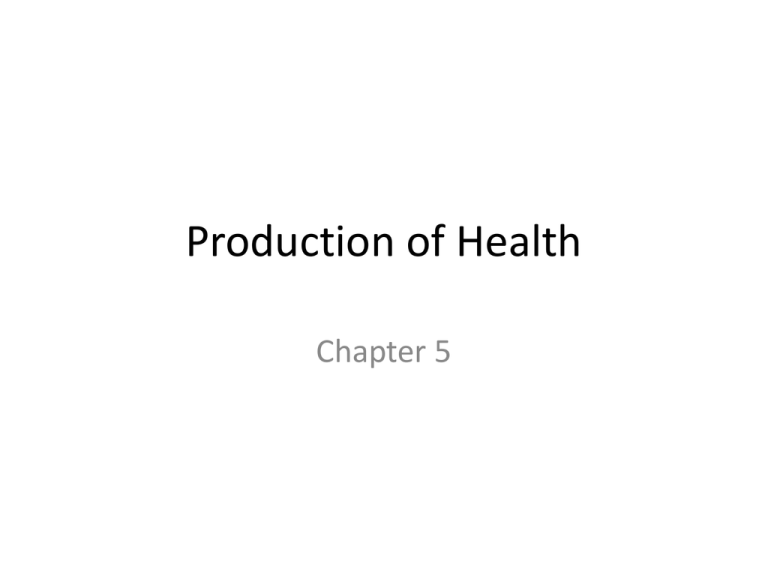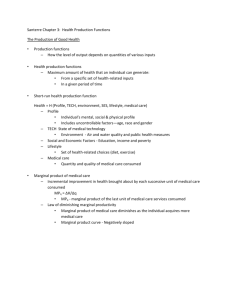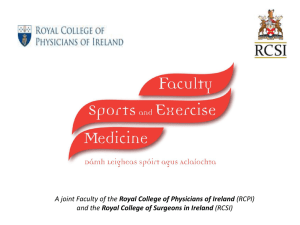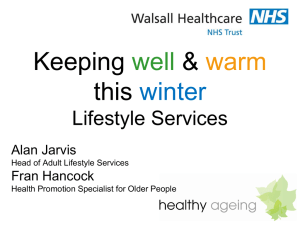Production of Health in ppt
advertisement

Production of Health Chapter 5 Chapter Outline • • • • The Production Function of Health The Inputs into the Production of Health The Role of the Government Conclusions THE PRODUCTION FUNCTION OF HEALTH Definition • The production function of health defines the relationship health and the health inputs needed to produce health. Total Product • Health status increases as more and more health care inputs are added to the production process. Figure 5-1 Production of Health A Marginal Product • Diminishing marginal product – as more and more health care inputs are added to the production process, the increments in heath status diminish. Figure 5-1 Production of Health B Marginal Product and Health Care Policy • From the perspective of public policy the marginal product is most relevant. For example, would it be better to reduce health care expenditures by $1 billion and invest those funds in another productive use, such as housing, education, or environmental programs? – The extra dollar should go to where the marginal product is highest. • In a developed economy the marginal product of healthcare spending is likely to much lower than in a developing economy. • In a developed economy you would probably be on the flat portion of the production function, so the marginal product is low • In a developing economy you would probably be on the increase part of the production function, so marginal product is high – As healthcare spending increases the marginal product falls The Production of Health • Health=f(Medical Care, Lifestyle, Environment, Human Biology) • Produce health with inputs: Medical care, Lifestyle, Environment and Human Biology Measuring Outputs • Health status is the output, but the issue is how to measure it. • There are many alternative measures, but we’ll focus on two: – Mortality: the number of deaths per 1000 of the population – Morbidity: the number of persons who have an illness or disease per 1000 of the population Medical Care • This is an obvious input, and probably the one that most people would think would be the most important. • However, medical care can also create some negative externalities (e.g., in Spectre reading, the inappropriate use of a tuberculosis test can make people worse off; pain killer addiction; side effects of some medical treatments). Medical Care • Many medical historians agree that practitioner-provided medical interventions played only a small, perhaps negligible, role in the historical decline in population mortality rates. Consider the following diagrams: Did Medicine Cause the Decline in Mortality Rates? Figure 5-3 Fall in the Standardized Death Rate per 1,000 Population for Four Common Infectious Diseases in Relation to Specific Medical Measures for the United States Source: Reprinted from Milbank Memorial Fund Quarterly/Health and Society, John B. Mckinlay and Sonja M. Mckinlay, “The Questionable Contribution of Medical Measures to the Decline of Mortality in the United States in the Twentieth Century, Milbank Memorial Fund Quarterly/Health and Society 55 (1977): 405–428, with the permission of Blackwell Publishers. Medical Care • These graphs indicate that most of the major declines in the prevalence of many infectious diseases occurred before the introduction of drugs used to treat them. • Where medical care is most effective is at really young ages, i.e., less than 1 year and especially less than 1 month (neonatal) since the death rates at these ages have decreased dramatically Medical Care • Medical care also matters more at older ages, where the incidence of heart disease and cancer is much higher. Generally, treatments for heart disease and cancer have improved, although with cancer much really depends on the pathology of the tumors (some types of cancers are easier to treat than others). Two Theories About the Role of Education and Medical Care • Michael Grossman’s (1972a, 1972b) theory of demand for health provides a central role for education. Grossman contends that better-educated persons tend to be economically more efficient producers of health status. • In contrast, Victor Fuchs (1982) has suggested that people who seek out additional education tend to be those with lower discount rates. Individuals with relatively low discount rates will be more likely to invest in education and in health as well. Medical Care • Research suggests that the elasticity of health care at the margin is 0.10 in the U.S. • Another calculation based on U.S. data, is that given current levels of expenditure on health care, a $100 billion expenditure on health care would result in an increase in life expectancy of 0.76 years spread over the population. • Both sets of estimates are consistent with medical care having a small marginal product Lifestyle • Lifestyle factors are sometimes called preventive measures, e.g., you have a healthy lifestyle and it makes you less likely to need medical care. • Lifestyle factors can also be complementary for medical care, e.g., if you have diabetes you might get nutrition counseling as well as instructions about exercise; if you have heart disease you might be asked to cut back on saturated fats, sodium and cholestrol. Lifestyle • This generally includes nutrition and exercise. – For example, diets high in saturated fats are associated with a higher risk of cardiovascular (heart disease) as well as some sorts of cancer. • Smoking would also be a lifestyle factor; – smoking is known to cause some types of cancers (e.g., lung, mouth, tongue, throat) and be a risk factor for some other types of cancer (e.g., kidney) as well as other respiratory diseases (Emphysema); as well as increase your risk of cardiovascular disease Lifestyle • Alcohol consumption can also be a risk factor, especially excessive consumption, for liver disease as well as heart disease and digestive problems among other problems • Occupations can matter, some workers can be exposed to hazardous materials at work and this can increase their risk of health problems – For example, firefighters have a higher risk of lung and some other cancers, coal miners get “Black Lung”, miners are higher risk of respiratory disease Lifestyle • Drug addiction can also have an effect on health – For example, intravenous drug users (e.g., heroine, cocaine) can have higher rates of HIV/AIDS and Hepatitis infections – Drug addicts often have higher rates of emergency room visits (overdose and other problems), which can be a cost to society. • Education can also play a role. Lifestyle • Socioeconomic Status and Health; – One stylized fact of health that is common to all countries in the world is that people with lower socioeconomic status have poorer health; this is often referred to as the “gradient in socioeconomic status”; while there is lots of evidence on the gradient the mechanism for how it works is not clear; e.g., could it be that lower socioeconomic status is correlated with lower levels of education (and it’s effect on health) or is it related to environmental factors … Environment • Where people live can matter for their health. • Access to clean drinking water can reduce the spread of diseases such as cholera and dysentery – Cholera and dysentery kill many people in developing countries who do not have access to clean drinking water; These diseases used to kill a lot of people in Canada, U.S. and Europe before the big public health initiatives in the 19th century which started water purification as well as treating sewage before dumping it Environment • From a historical perspective, there used to a difference in mortality between rural and urban areas (rural areas had lower mortality rates, some of this could be attributed to access to better drinking water); today urban areas can have higher rates of air pollution and this can lead to greater incidence of respiratory problems or emergency room visits for people with Asthma Environment • There are a number of measures of air quality, one is the Air Quality Index, which includes a measurement known as the PM2.5, quantifies the concentration of particles less than 2.5 micrometers (e.g., sulphates, nitrogen dioxide, ozone) which are thought to have adverse effects on health; when inhaled these small particles can increase risk of heart attacks, cancer and acute respiratory infections, especially in children and the elderly. Smog in Beijing Smog in Toronto Environment • The World Health Organization (W.H.O.) guidelines on particulate matter sets a target of 10 for the PM2.5 as an upper bound on the safe level; – In Toronto, the daily range of the PM2.5 is 4-24 – In Hamilton, the daily range of the PM2.5 is 6-24 – In Beijing, the PM2.5 averaged 101.3 in 2013 – In Hadan (a big steel production centre in China), the PM2.5 averaged 130.5 in 2013 Environment • Another environmental factor can be the control of mosquito borne diesases; – Malaria, used to be a problem in the southern U.S. states as well as southern Europe; solution was to drain marshland and swamps, where mosquitoes are in large concentration, – West Nile Virus, great concern in North America; generally leave pesticides in storm catch basins as well as advising people to not have water standing around their houses Environment – Dengue Fever, another mosquito borne disease, is becoming more a concern in the U.S.; Dengue Fever has been spreading around the world. Dengue Fever: Texas vs Mexico Spread of Dengue Fever Environment • Dengue fever has a lower incidence rate in Texas than in Mexico; – Some plausible explanations include: Mexicans are poor and can’t afford air conditioning, so they spend more time outside than Texans; Mexicans don’t have screens on their windows, so its easier for mosquitos to get inside; Human Biology • Genetics; inter-generational links for some diseases, e.g., some forms of cancer, heart disease, some mental health disorders • Differences by gender in some diseases; e.g., some blood disorders (low platelet count may be more common in women) and race (black men have a higher risk of prostrate cancer, south asians have a higher risk of diabetes) • Not much that can be done about genetics, except get treatment The Role of the Government • In most (developed) countries the government plays a larger role in the production of health. • In terms of medical care, the government is involved in provided medical care, whether paying for it with taxes or with subsidies to individuals in almost all developed countries • However, the government can also have effects on the other inputs, except for human biology. Public Health vs Health Promotion • Public Health – Sewage Treatment and water purification – Controlling Mosquito borne diseases – Controlling pollution to maintain the quality of drinking water and air quality – Food safety – Health and Safety Regulation • Health Promotion – Promoting Healthy lifestyles, better nutrition and getting people to exercise more – Controlling smoking and excessive alcohol consumption – Raising awareness about diseases or vacation programs (like those for the flu or children) Public Health vs Health Promotion • Public health programs include government initiatives to provide clean drinking water and immunization programs. • Health promotion is about bringing attention to some sort of illness (i.e., early screening or testing) or some sort of lifestyle changes that would improve health (better nutrition and more exercise). • All levels of government can engage in health promotion, and there are a number of ways they do so. • Some use webpages, some examples might include • http://www.participaction.com/getmoving/bring-backplay/?gclid=CLuLu83sm7sCFeVcMgodahIAdA • Focused on increasing exercise, particularly in children (reduce obesity and related health problems) • Eating healthy http://www.hc-sc.gc.ca/hlvs/eat-aliment/index-eng.php • Toronto Public Health http://www1.toronto.ca/wps/portal/contento nly?vgnextoid=a253ba2ae8b1e310VgnVCM10 000071d60f89RCRD – Provides information on various clinics run by the city, immunization programs, and other programs the city offers. • Health promotion can be a little broader than the government though, sometimes other non-profit organizations can be involved as can some private organizations, and they may even partner with the government. • In addition, to websites health promotion is often facilitated through advertising in magazines or outdoors or on public transportation or even with product warnings. Examples of ads raising awareness or pointing out health risks Advertising a Vaccine for Cervical Cancer: UK vs Canada • Generally, public health programs are focused on environmental factors in terms of the inputs used to produce health • Health promotion is mostly targeted to lifestyle factors, although it can also increase the use of medical care if it is about raising the awareness or highlighting the symptoms of some health problem. What is Bottomline? • It’s tricky to sort out what the most factor for producing health because of uncertainty, a lot of things might produce the patterns we see in the data.








